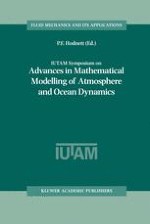2001 | Buch
IUTAM Symposium on Advances in Mathematical Modelling of Atmosphere and Ocean Dynamics
Proceedings of the IUTAM Symposium held in Limerick, Ireland, 2–7 July 2000
herausgegeben von: P. F. Hodnett
Verlag: Springer Netherlands
Buchreihe : Fluid Mechanics and Its Applications
Enthalten in: Professional Book Archive
